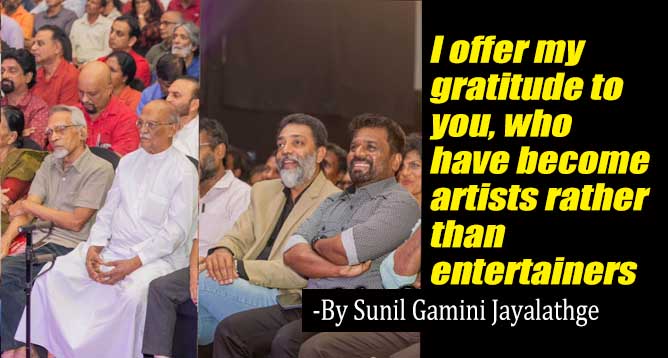-Written by Sunil Gamini Jayalathge

(Lanka-e-News -12.Sep.2024, 10.45 pm) Under the theme "The Futurist Movement of Art for Revival", a program by the National People's Force regarding artists was launched on the 8th at Rajagiriya. It was a joyous occasion to see a large number of artists from various fields in Sri Lanka attending.
I was compelled to write this note because my past memories resurfaced after encountering a remarkable person who attended the event. That extraordinary person is Hemasiri Liyanage.
When I was in the 10th grade at Gamini Maha Vidyalaya, Ingiriya, two new teachers joined our school. One was a teacher of Buddhism, while the other, in the absence of our Sinhala teacher, taught us Sinhala. This teacher was Hemasiri Liyanage, and the teacher of Buddhism was his kind wife, Kusum Liyanage.
At that time, we did not know much about him. However, after some time, we learned that he was a good dramatist and an actor. Their young child, Saumya Liyanage, would sometimes accompany them to school.
During this time, a student named Chandana Vithanage joined our higher grades from Horana. Although we initially had conflicts with him as the new student, he later became my best friend. He was a strong critic of the existing social and political systems. He proposed forming a student union to discuss student issues, which led us to establish a branch of the Lanka Students' Federation, affiliated with the Nawa Sama Samaja Party.
Thus, I became involved with the Nawa Sama Samaja Party. At that time, my economics teacher was Siyambalapitiya Sir, who was associated with the Communist Party. In his absence, Hemasiri Liyanage would often step in to teach us.
During my advanced level classes, we prepared and distributed a leaflet within the school under the name of the Lanka Students' Federation, criticizing the UNP government's education policies and budget cuts. As a result, the principal unexpectedly suspended me from school for three months.
After the suspension period ended, the deputy principal extended the suspension, prompting me to enroll at Vidyarathna Pirivena in Horana for my advanced level studies.
After that, I did not encounter Siyambalapitiya Sir or Hemasiri Liyanage Sir again. However, while participating in the activities of the Nawa Sama Samaja Party in Horana, I frequently visited Hemasiri Liyanage's home, helping with party newspapers and fundraising.
It was during this time that I realized Hemasiri Liyanage was a leftist.
In 1983, I left Ingiriya to fully engage in politics with the Nawa Sama Samaja Party, eventually becoming a member of its Central Committee. I served as the secretary of the youth wing and was responsible for the editing, page layout, and printing of the party's official newspaper, Hara.
Despite the political split within the party, I returned to Ingiriya in 1992 but continued political activities within the local branch.
During this time, Mahinda Rajapaksa was the Leader of the Opposition. On July 1, 1992, he planned a nationwide protest against the UNP government, known as the Jana Ghosha. Leftist parties also expressed their support for this movement.
Representing the Nawa Sama Samaja Party's Ingiriya branch, our group gathered near the Bo tree, while the SLFP supporters gathered near the bus stand close to the police station.
At exactly noon, the Jana Ghosha protest began. SI Sirimal and a group of armed policemen arrived, and along with local UNP politicians, they attacked us with clubs.
The police used their rifles to beat us, and the leader of the SLFP group, Dayasena Amarathunga (my maternal uncle), also became a target of the police. Several of us, including me, were admitted to the Ingiriya hospital due to injuries.
Later, I learned that Hemasiri Liyanage had also participated in the Jana Ghosha in Horana, where he was attacked by the police, resulting in a broken tooth. The police were ordered to pay him compensation for the injuries.
In a historic judgment on March 8, 1993, Justice Mark Fernando ruled that this incident was a violation of the fundamental right to express one's views and ordered the government to pay Dayasena Amarathunga Rs. 50,000 as compensation.
The Jana Ghosha case in Ingiriya is still referred to in teaching law and in fundamental rights cases. The case is recorded in the Sri Lanka Law Reports 1993 Vol 264.
It was heartwarming to see my former teacher, Hemasiri Liyanage, seated at the artists' assembly of the National People's Force while his son, Professor Saumya Liyanage, stood on the stage.
This scene rekindled my memories. While some artists and their children bow down to rulers, singing praises and filling their bellies, Hemasiri Liyanage and his children remain aligned with the aspirations of the common people, making a remarkable contribution.
---------------------------
by (2024-09-12 19:36:18)
Leave a Reply